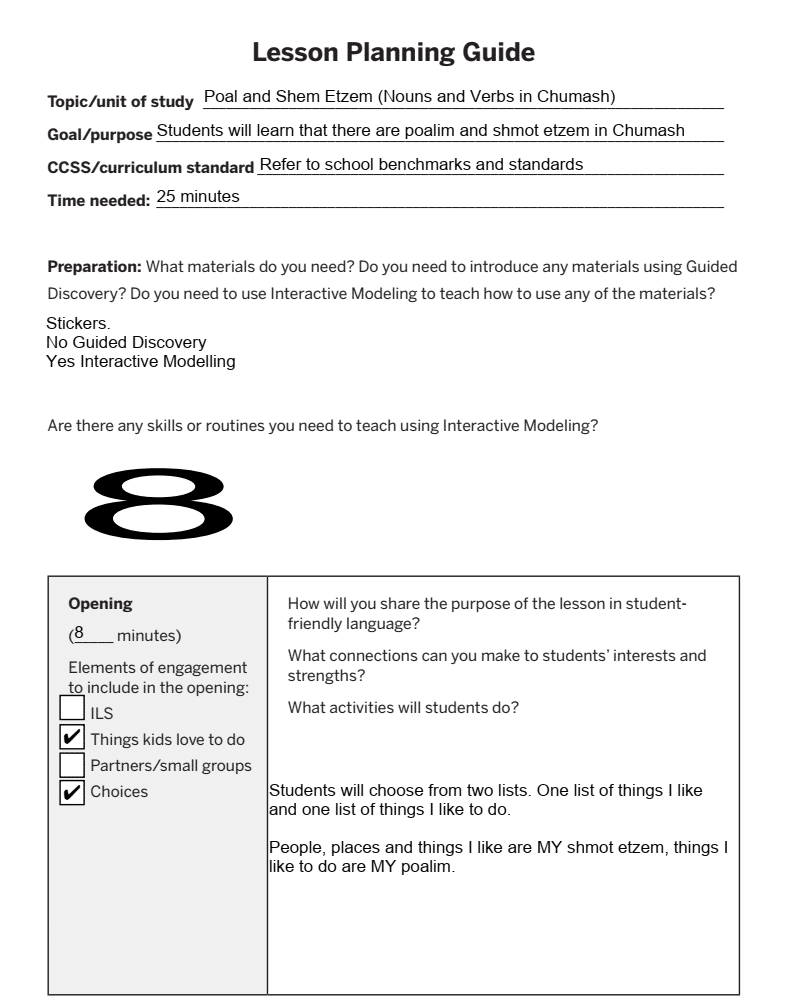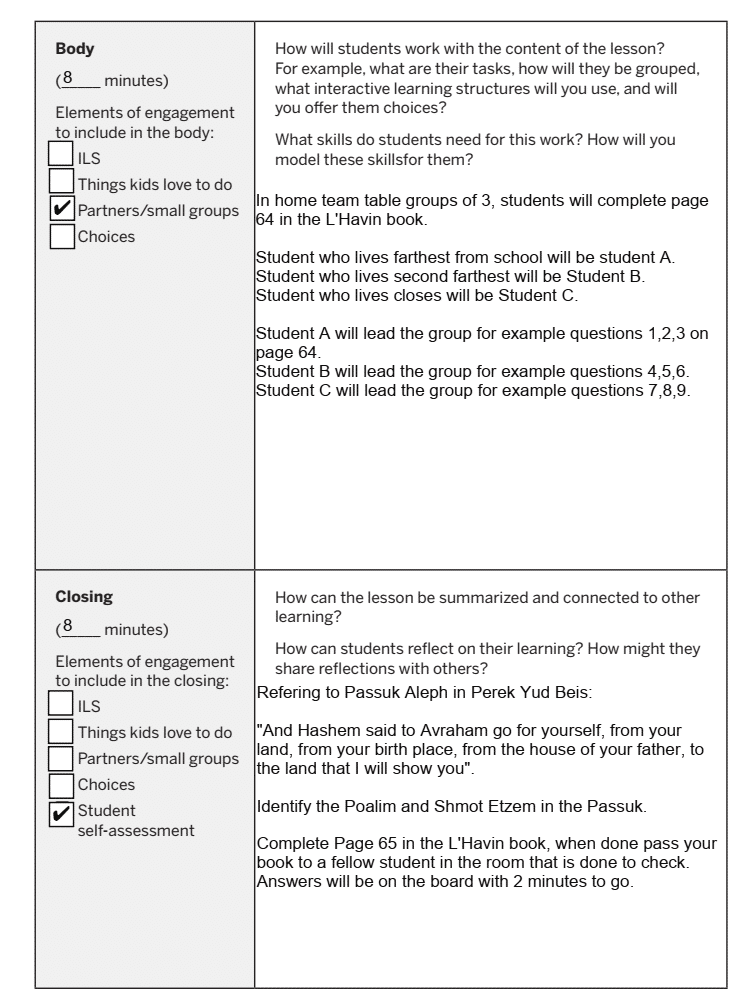
Is it ADHD or is it Something Else?
July 18, 2022
Teaching the Story of our אמונה
July 18, 2022By Rabbi Dovber Chaiton
Often, the resources available to Torah Studies teachers are more limited than those available to General Studies. Responsive Classroom can be used an approach to giving ADHD students access to the Torah curriculum as opposed to looking for resources. In this article, I will outline how teachers can use Responsive Classroom to provide the opportunity for Torah Studies learners to access curriculum alongside their peers, as opposed to bringing in specific resources that make their learning different to their peers. I will place particular focus on using the COJDS L’Havin curriculum together with the Responsive Classroom approach.
The Extra Challenge of ADHD in a Torah Studies Class
It has been well researched that often students with ADHD are educated by teachers not specifically trained to deal with ADHD[1]. This is particularly compounded when it comes to the Jewish Day School classroom. While special education in the Torah Studies world has come on in leaps and bounds, it is quite understandable that students with ADHD will not form a large enough group in most areas to have their own class. In addition to this, when intervention is needed, the public school system with their supports may be a viable option, but for the most part a typical Jewish day school classroom will have ADHD students.
Torah studies teachers have the additional challenge of also having limited resources to work with as opposed to their general studies colleagues who have more resources available to them.
Responsive Classroom
Responsive Classroom is a student-centered, social and emotional learning approach to teaching and discipline. It is comprised of a set of research- and evidence-based practices designed to create safe, joyful, and engaging classrooms and school communities for both students and teachers.[2]
The core belief of Responsive Classroom is that in order to be successful in and out of school, students need to learn a set of social and emotional competencies—cooperation, assertiveness, responsibility, empathy, and self-control—and a set of academic competencies—academic mindset, perseverance, learning strategies, and academic behaviors.[3]
There are multiple layers of integration between the social and emotional competencies and the academic competencies. It is a symbiotic relationship whereby the academic competencies are firmly built on the sureties and steadiness of the social and emotional competencies that have been ingrained in learners from the outset of the year.
Structure for ADHD Students
According to numerous professionals including Jeanne Segal, Ph.D. and Melinda Smith, M.A.[4], ADHD students thrive under a classroom with definite structure. Structure provides two things that ADHD students crave, consciously or subconsciously: organization and predictability.
The Responsive Classroom approach to classroom structure and management lays out a model for organization and predictability. The exact same approaches that would suit a general studies program would work for a Torah studies class. In fact, aside from the curriculum and subject matter, every technique and lesson structure that is appliable in general studies with the Responsive Classroom approach is also possible in a Torah Studies classroom.
The Resource Trap
Consistently looking for resources to differentiate with and provide to ADHD students is a trap. Firstly, it traps the Torah studies teacher due to the limited resources that are available. Secondly – and more detrimentally to the ADHD students’ learning – it removes the organization and predictability of the lesson for the students who need it most.
For example, let’s say that the Torah studies teacher starts class by providing a resource packet or special computer application to the ADHD student and requires the rest of the class to take out their regular textbook. This seems to be a good option, but the element of predictability and organization has been replaced by the element of surprise, for a student who needs organization and predictability most.
The more profound issue with looking for alternative resources for students with ADHD is the fact that teachers will often be differentiating to a lower academic ability when that in fact is not the issue at all. Easier work may keep ADHD students engaged, but this is no doubt falling short of the ultimate goal in school which is challenging and stimulating student learning.
The differentiation should be in the emotional approach to the curriculum at hand. This differentiation is easily implemented in the Responsive Classroom approach where a few minor tweaks can mold the approach to the needs of the ADHD students without changing the subject matter or academic goals.
The Curriculum-Above-All Trap
When setting up a Responsive Classroom, it is essential to set behavioral expectations through collaboration with the students. Establishing the emotional norms and expectations of the classroom is a process which is time consuming when done properly. Teachers often fall into the trap of placing the academic curriculum above all, even at the expense of enshrining emotional and behavioral norms within which a safe and predictable learning environment can thrive. Setting up the classroom for success is even more essential to ADHD students. ADHD students certainly require predictability and structure for their academic learning but even more so for their emotional and behavioral learning.
Diving into curriculum prior to setting up these structures is not a short cut at all; it will only serve to add time in teaching and making-up behavioral norms on the fly in the future. Taking the time, even if it is longer than expected, to set up the responsive emotional and behavioral classroom, is a sure way to save time for academic work and teaching down the line. This is profoundly so with ADHD students.
Torah studies teachers often push-back at the implementation of the Responsive Classroom as the time it takes to set-up the norms that ingrain social and emotional competencies takes away from teaching time. It is essential to remember that learning and teaching Torah is never a quantitative endeavor. There are certainly benchmarks and targets to ensure that students are gaining the necessary skills, but Torah learning has the goal of setting up a student to be entrenched in the thoughts of Hashem for life. It is well worth setting up the emotional and behavioral standards that will make this experience a pleasant one for ADHD and neurotypical students alike.
COJDS L’Havin and Responsive Classroom for ADHD Students
The L’Havin curriculum is an example of a curriculum that has enough differentiation and thought-out work material in it to engage ADHD students. Torah studies teachers may be inclined to seek out an alternative resource for ADHD students who are “acting up” when the L’Havin curriculum is being taught or worked on. With a Responsive Classroom Approach, the L’Havin curriculum is easily implementable even for ADHD students and further resources should not be needed.
This is best demonstrated through a sample lesson plan.


- L’havin has multiple follow-up exercises on every new skill learned. This is a great way to use one of the review pages as a group exercise and another one of the exercises as a summary assessment.
- L’Havin makes it very clear when a new skill is being taught or comes up in the book.
- L’Havin has many review pages that are not linked to the skill learned. These are great for a Do It Now exercise or a welcoming exercise to have the class settled prior to instruction.
- Use creative Torah ways to create homegroups for the L’Havin curriculum. Even within the homegroups, use creative Torah ways to assign who will do which task in the group. This does not detract from the L’Havin curriculum and also provides an opportunity for ADHD students to be stimulated without using alternative resource.
Example: Your homegroups for this month will be based on the shalosh regalim. All those with birthdays between Pesach and Shavuos will be homegroup A, between Shavuos and Sukkos homegroup B, between Sukkos and Pesach homegroup C. Your order of leading the group for today will be based on Alef Bet order for your first Jewish names. It may take students longer to figure out the Shalosh Regalim, but that is ok, as this will be done once a month. It will be shorter to figure out the Alef Bet order and that is ok as that is a daily break up.
In Summary
The need to adequately educate ADHD students is not fixed by seeking alternative resources and work packets. It is fixed by providing an environment which lends itself to learning. While Torah studies do not have the same resources available as general studies teachers, the Responsive Classroom approach is as implementable in a Torah Studies classroom as it is in a General Studies classroom.
The Responsive Classroom approach ensures that curriculum is accessible to ADHD students and their neurotypical classmates alike. The COJDS L’Havin curriculum is perfectly compatible with the Responsive Classroom approach and when implemented together it allows ADHD students to access the L’Havin Chumash curriculum alongside their peers.
[1] https://www.cdc.gov/ncbddd/adhd/school-success.html
[2] https://www.responsiveclassroom.org/#:~:text=Responsive%20Classroom%20is%20a%20student,for%20both%20students%20and%20teachers.
[3] https://www.responsiveclassroom.org/about/principles-practices/
[4] https://www.helpguide.org/articles/add-adhd/attention-deficit-disorder-adhd-and-school.htm
Rabbi Dovber Chaiton is a teacher at Emek Hebrew Academy Teichman Family Torah Center. Rabbi Chaiton has experience teaching elementary, middle and high school. He serves as the boy’s division director for Kol Yakov Yehuda, Junior Congregation of Los Angeles. Rabbi Chaiton received smicha from Rabbi Israel Meir Lau and Rabbi Chaim Shapiro at the Rabbinical College of America in Morristown, New Jersey. He is a voluntary chaplain for the Los Angeles County Probation Department. Rabbi Chaiton can be contacted at [email protected].

